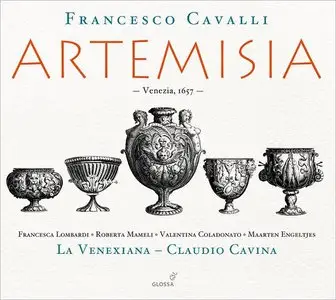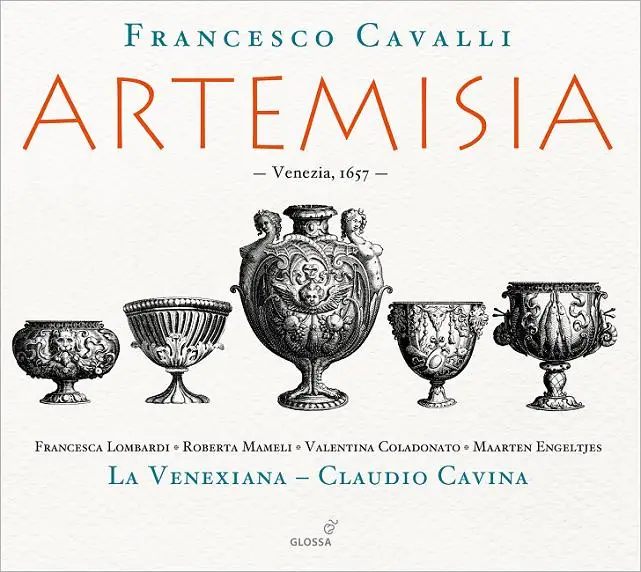Francesco Cavalli - Artemisia [Venexiana]
Glossa | 2011 | 3 CD | RAR 210Mb | Booklet (Mb)
MP3 192 Kbps | Lame encoded | Tracks | Cover | Fserve, Fsonic
Glossa | 2011 | 3 CD | RAR 210Mb | Booklet (Mb)
MP3 192 Kbps | Lame encoded | Tracks | Cover | Fserve, Fsonic
Singers in the established style of La Venexiana, including the vocal star of 'Round M, Roberta Mameli and, recent finalist in the Handel Singing Competition, Francesca Lombardi Mazzulli (who takes the role of the love-torn Queen Artemisia, a character strong enough to drink her dead husband's ashes…) give vent to this glorious display of Venetian operatic splendour.
Where next for Claudio Cavina and La Venexiana after their exhilarating run of recordings of Monteverdi madrigals, operas and much more? One route is proving to be in the direction of Francesco Cavalli, the 17th century composer who spent much of his working life in Venice, starting off as a chorister in St Mark's Basilica when Monteverdi himself was in charge. Although Cavalli has been known as a composer of Venetian seicento sacred music, it is his prolific contribution in the field of opera where he became one of the leading figures involved in the development of commercial opera companies from the 1640s onwards - that has been receiving greater attention from artists in more recent times. And it is with a dramma per musica in Artemisia from the mid 1650s, with its tale of love, deceit and honour and the upholding of the virtues of the Venetian Republic (all this richly captured by the expressive style of Cavalli), that Cavina has chosen to contribute to that fresh look at Cavalli's music on this new recording from Glossa.
ARTEMISIA
Music by Francesco Cavalli
Libretto by Nicolò Minato
Premiered in Venice in 1657
Music by Francesco Cavalli
Libretto by Nicolò Minato
Premiered in Venice in 1657
01 Sinfonia. Artemisia, Eurillo, Indamoro: Dure selci
02 Artemisia, Meraspe: Ecco il mio vago
03 Meraspe, Ramiro, Artemia: Dubbia m’appar
04 Oronta, Niso: Che saetti ed incateni
05 Alindo, Oronta, Niso: Son le luci ch’adoro
06 Ramiro, Artemia, Meraspe: Quando il cor
07 Artemisia, Artemia, Meraspe: Amori, eh?
08 Indamoro, Artemisia, Meraspe: Pur andò l’importuno
09 Meraspe, Artemisia, Eurillo, Ramiro: Gl’artefici o Regina
10 Erisbe, Niso: Su l’April
11 Artemia, Ramiro: Zeffiretti placidetti
12 Artemisia, Meraspe: Hor che soli restiamo
13 Artemisia, Meraspe, Alindo: Clitarco prenditi un fior
14 Oronta, Alindo, Niso: Gran favor! Gran mercede!
15 Artemia, Ramiro: Ardo, sospiro, e piango
16 Alindo, Artemisia, Meraspe: Già del vostro Nettuno
17 Niso, Erisbe: Cari, cari vegetabili
02 Artemisia, Meraspe: Ecco il mio vago
03 Meraspe, Ramiro, Artemia: Dubbia m’appar
04 Oronta, Niso: Che saetti ed incateni
05 Alindo, Oronta, Niso: Son le luci ch’adoro
06 Ramiro, Artemia, Meraspe: Quando il cor
07 Artemisia, Artemia, Meraspe: Amori, eh?
08 Indamoro, Artemisia, Meraspe: Pur andò l’importuno
09 Meraspe, Artemisia, Eurillo, Ramiro: Gl’artefici o Regina
10 Erisbe, Niso: Su l’April
11 Artemia, Ramiro: Zeffiretti placidetti
12 Artemisia, Meraspe: Hor che soli restiamo
13 Artemisia, Meraspe, Alindo: Clitarco prenditi un fior
14 Oronta, Alindo, Niso: Gran favor! Gran mercede!
15 Artemia, Ramiro: Ardo, sospiro, e piango
16 Alindo, Artemisia, Meraspe: Già del vostro Nettuno
17 Niso, Erisbe: Cari, cari vegetabili
01 Oronta, Alindo: S’Amor vuol così
02 Artemisia, Meraspe, Indamoro: Che sospiri Clitarco?
03 Artemia, Ramiro: Ver me un sol fiato
04 Niso, Erisbe, Eurillo: Perdon ti chiedo
05 Indamoro, Artemisia, Eurillo, Niso, Erisbe: Di trombe guerriere
06 Erisbe, Niso: Niso, Niso!
07 Meraspe, Artemisia: Cara, cara de gl’occhi miei
08 Artemisia, Alindo, Artemia, Meraspe: Ella è quì
09 Erisbe, Niso, Eurillo: Hor vieni ad abbellirmi
10 Artemia: Se Meraspe crudel
11 Meraspe, Artemisia: Altri è gradito
12 Meraspe, Artemisia, Alindo: Che gratie!
13 Artemia, Ramiro: Dir, ch’io v’amo
14 Artemisia, Indamoro: Indamoro!
15 Erisbe, Eurillo, Niso: Se tu vuoi ch’io t’ami
02 Artemisia, Meraspe, Indamoro: Che sospiri Clitarco?
03 Artemia, Ramiro: Ver me un sol fiato
04 Niso, Erisbe, Eurillo: Perdon ti chiedo
05 Indamoro, Artemisia, Eurillo, Niso, Erisbe: Di trombe guerriere
06 Erisbe, Niso: Niso, Niso!
07 Meraspe, Artemisia: Cara, cara de gl’occhi miei
08 Artemisia, Alindo, Artemia, Meraspe: Ella è quì
09 Erisbe, Niso, Eurillo: Hor vieni ad abbellirmi
10 Artemia: Se Meraspe crudel
11 Meraspe, Artemisia: Altri è gradito
12 Meraspe, Artemisia, Alindo: Che gratie!
13 Artemia, Ramiro: Dir, ch’io v’amo
14 Artemisia, Indamoro: Indamoro!
15 Erisbe, Eurillo, Niso: Se tu vuoi ch’io t’ami
01 Artemia: Ch’io peni così
02 Artemisia, Artemia, Meraspe: Artemia?
03 Oronta, Alindo: Dammi morte
04 Artemisia, Meraspe: Ecco il mio bene
05 Artemisia, Indamoro, Meraspe, Artemia: Servi, ò là
06 Erisbe, Niso, Eurillo: Dite il vero, son nera?
07 Artemisia, Eurillo: Cor mio che sarà
08 Alindo, Artemisia: E che fia mai quel foglio?
09 Artemisia, Meraspe: Veggio venir Clitarco
10 Ramiro, Alindo, Artemia: Hor siate à preghi miei
11 Artemisia, Meraspe: Al fin vuole il mio Fato
12 Erisbe, Niso, Eurillo: Non oso alzar le ciglia
13 Meraspe, Oronta: Respiri, chiudete
14 Oronta, Indamoro, Artemisia, Meraspe: Ma’ sen viene Artemisia
15 Alindo, Artemisia, Eurillo: Regina?
16 Oronta, Meraspe, Artemisia, Alindo, Artemia, Ramiro, Eurillo: Ecco Alindo
02 Artemisia, Artemia, Meraspe: Artemia?
03 Oronta, Alindo: Dammi morte
04 Artemisia, Meraspe: Ecco il mio bene
05 Artemisia, Indamoro, Meraspe, Artemia: Servi, ò là
06 Erisbe, Niso, Eurillo: Dite il vero, son nera?
07 Artemisia, Eurillo: Cor mio che sarà
08 Alindo, Artemisia: E che fia mai quel foglio?
09 Artemisia, Meraspe: Veggio venir Clitarco
10 Ramiro, Alindo, Artemia: Hor siate à preghi miei
11 Artemisia, Meraspe: Al fin vuole il mio Fato
12 Erisbe, Niso, Eurillo: Non oso alzar le ciglia
13 Meraspe, Oronta: Respiri, chiudete
14 Oronta, Indamoro, Artemisia, Meraspe: Ma’ sen viene Artemisia
15 Alindo, Artemisia, Eurillo: Regina?
16 Oronta, Meraspe, Artemisia, Alindo, Artemia, Ramiro, Eurillo: Ecco Alindo
Francesca Lombardi Mazzulli (Soprano), Artemisia
Roberta Mameli (Soprano), Artemia
Valentina Coladonato (Soprano), Oronta
Maarten Engeltjes (Countertenor), Meraspe
Andrea Arrivabene (Countertenor), Alindo
Marina Bartoli (Soprano), Ramiro
Silvia Frigato (Soprano), Eurillo
Salvo Vitale (Bass), Indamoro
Alberto Allegrezza (Tenor), Erisbe
Alessandro Giangrande (Countertenor), Niso
La Venexiana
dir. Claudio Cavina
Roberta Mameli (Soprano), Artemia
Valentina Coladonato (Soprano), Oronta
Maarten Engeltjes (Countertenor), Meraspe
Andrea Arrivabene (Countertenor), Alindo
Marina Bartoli (Soprano), Ramiro
Silvia Frigato (Soprano), Eurillo
Salvo Vitale (Bass), Indamoro
Alberto Allegrezza (Tenor), Erisbe
Alessandro Giangrande (Countertenor), Niso
La Venexiana
dir. Claudio Cavina
Francesco Cavalli was one of the most famous composers of the 17th century. Almost four centuries later the opera world is beginning to take notice of the Venetian composer once again. New editions of Il Giasone and L’Artemisia published by Bärenreiter support this renaissance.
L’Artemisia
“I have endeavoured to do nothing other than to present to you the characteristics of the human passions in a natural way.” So Cavalli’s librettist Nicolò Minato addressed the theatre-going public in the foreword to L’Artemisia. He then added the wish that the public would rather see opera on the stage instead of just reading the libretto. The public was happy to respond to this wish, since the music of the opera was by no less than the most famous and popular opera composer of his day. Francesco Cavalli was in addition particularly interested in the portrayal of the passions, more than the general attributes of his characters; and thus, he proved himself the ideal partner to Minato in setting his opera to music. In Artemisia, both had chosen an extremely suitable character for their concepts; she was regarded in the 17th century as the personification of a strong and independent woman, whilst particularly faithful to her husband Mausolos. She remained so devoted to him even after his death, that she was even said to have drunk his ashes in order to maintain a bond with him.
What next, Cavalli and Minato wondered, if such a woman was confronted with a new love and, what’s more, with a man from a lower social class? And if, on top of everything, this man turned out to be the person who killed her husband? Confronted with these problems, she has to examine her self-image and her role as queen, something which Cavalli exploits in masterly fashion to portray the inner conflicts and her change of personality musically. At the end comes the realization “forgive my enemies”; wars are called off, adversaries pacified and – finally, we are in the baroque – marriages made.
The plot is enlivened through the use of a whole baroque range of characters including jealous lovers, vociferous, then timid generals, a ghost, recalcitrant and unreliable servants and their wet-nurses lamenting lost youth, all of whom Cavalli and Minato wove into the plot in an original way. Yet, as in the comedies of Shakespeare, serious themes are always presented in humorous, comic scenes with a certain gravity, so that the audience is both entertained and moved.
This all happens in Cavalli’s most expressive musical language which is capable of achieving the greatest effects with the smallest means. The diversity of the passions, and in particular their changes of mood, is reflected in the music in an extensive range of forms of expression. A repertoire of possibilities, probably unique in the history of opera, ranges from matter-of-fact recitative to major aria. In comparison with the early Cavalli operas which are generally performed nowadays (such as La Didone, Il Giasone and La Calisto), L'Artemisia is distinguished above all through its even greater mastery in the shaping and use of arias, which the composer exploits to portray characters and situations with affection and precision. He is, however, able to skilfully integrate this rather reflective function of his arias into the strand of the plot, so that no break in content between aria and recitative is apparent. As a result, the major arias are not independent numbers, but form part of the whole – as, for example, the aria “Ardo, sospiro, e piango”, which became well-known through Raymond Leppard’s highly-acclaimed performance of Calisto at Glydebourne in 1970, sung by Janet Baker.
L'Artemisia was premiered in January 1657 in Venice and proved – according to everything that we know of it – to be a great success. The first performance using the new scholarly edition will be given on 26 June 2010 at the Festival in Hannover-Herrenhausen by Claudio Cavina and La Venexiana. The work is now available for the first time in a modern edition.
Hendrik Schulze
(from [t]akte 1/2010)



